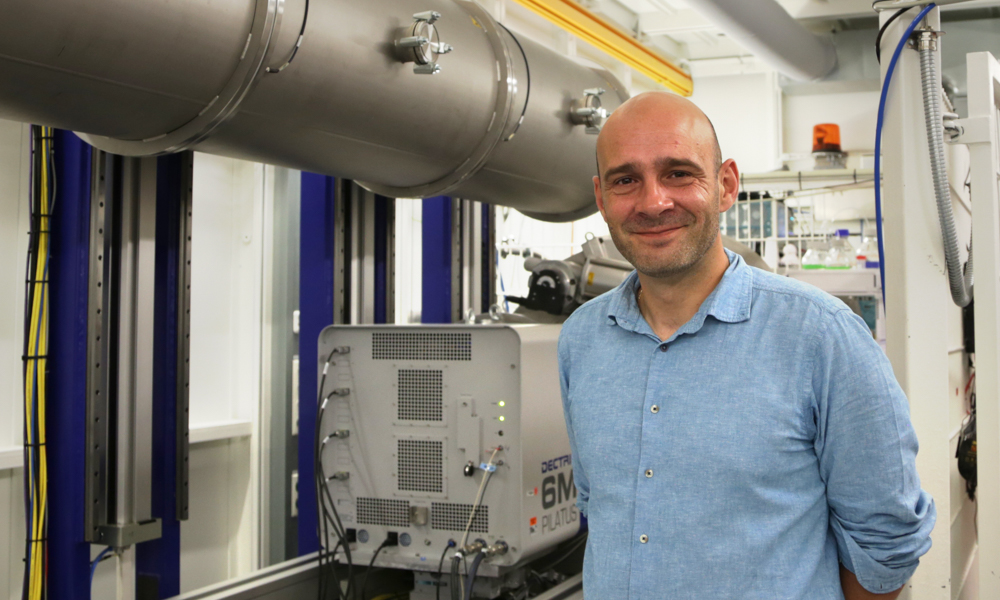
Welcome: Clément Blanchet
Clément Blanchet and his team at EMBL Hamburg advance the development of small-angle X-ray scattering (SAXS) and offer related services and training

Clément Blanchet, EMBL Hamburg’s newest Team Leader, is not a newcomer to EMBL. He joined EMBL Hamburg 15 years ago as a postdoc in the Svergun Group, specialising in biological small-angle X-ray scattering (SAXS). Now, as a newly appointed Team Leader, he continues Dmitry Svergun’s work on advancing the SAXS technology and offering essential services and training to the scientific community.
In this interview, he shares insights into the future developments of SAXS at EMBL Hamburg. He also delves into his journey of scientific passion, including a memorable ‘aha’ moment in his early career that left a lasting impression.
How did you become interested in science?
I’ve always been intensely curious about the world, which naturally drew me to science and technology for concrete answers. Growing up in a family of skilled technicians, including mechanics and electricians, I was surrounded by street-smart problem-solvers who could almost fix anything just by looking at it. Their approach profoundly shaped my thinking and curiosity, laying the foundation for my scientific journey.
As I craved more knowledge, I specialised in biotechnology instrumentation at the Physics School of Grenoble. Advancements in modern biology that allowed quantitative exploration of complex phenomena captivated me. Continuing my academic journey, I pursued a master’s degree and a PhD, focusing on protein folding and formation of amyloid plaques in neurodegenerative diseases. Through various advanced techniques, I gained a comprehensive understanding of this process, igniting my passion for scientific challenges and the instruments used to study them. This led me to embark on my journey at EMBL Hamburg, where I further developed scientific techniques and instruments.
Tell us about your work at EMBL.
We specialise in small angle x-ray scattering (SAXS), a technique for studying the structure and conformational changes of biological macromolecules in solution. We operate the advanced P12 beamline, providing beamtime to the scientific community, offering data collection assistance, and continuously upgrading the beamline for improved performance and expanded experiments. Additionally, we organise courses and conferences to train young scientists, foster the SAXS community, and promote this method. Through our SAXS service, we also engage in scientific collaborations, setting up special experiments, and providing expertise in SAXS data analysis and interpretation.
What are your ambitions for the future work of the SAXS team?
We are proud to continue the successful SAXS service, built upon the groundwork laid by our Dmitri Svergun. We aim to continue developing our methods, leveraging the recent revolution in structural biology (cryo-EM and AlphaFold) that has made high-resolution structures readily available. Although SAXS cannot provide atomic coordinates, integrating high-resolution structures, even hypothetical ones, proves extremely valuable in analysing SAXS data. Validated in solution, the high-resolution structure serves as a starting point to study structural changes induced by perturbations. By systematically integrating AlphaFold models for data analysis and interpretation, as well as developing new sample environments for high-throughput and time-resolved SAXS, we unleash the full potential of 4D structural biology, examining not only the three-dimensional structure of proteins but also their evolution over time and in response to their environment.
What excites you most about doing science at EMBL?
What excites me the most is the incredible diversity present in every aspect of my job. I get to collaborate with experts from various disciplines, including biologists, physicists, mathematicians, IT specialists, mechanics, and electronics experts. While operating the beamline, I encounter a wide range of scientific subjects, from studying proteins to lipid assemblies, bones, and lipid nanoparticles used in mRNA vaccine delivery. Moreover, interacting with colleagues from diverse countries and cultures has profoundly broadened my perspective and fostered an inclusive and enriching environment at EMBL.
What’s been the best advice you’ve gotten along the way?
Not exactly advice, but I had an ‘aha’ moment early in my career. I recall during my PhD, I was fascinated by protein folding and misfolding, using various techniques to piece together a general model. After many experiments, I had a draft model, but the next Nuclear Magnetic Resonance experiment delivered results contradicting my hypothesis. When the results popped up on the screen, I was deeply annoyed while my supervisor said, “This is interesting.” This moment taught me a lot about the spirit of scientific discovery.
What is the book you are most likely to recommend to people you meet?
I highly recommend ‘A Short History of Nearly Everything’ by Bill Bryson. It’s a fascinating book that explores scientific discoveries with humour and engaging storytelling, making it an enjoyable and informative read for everyone.
What would be one thing we couldn’t find out about you from an online search?
You know, if you were to search me online, you’d probably find my internet twin sharing my name and fame! They’ve cleverly managed to grab most of the web traffic, leaving my true self hidden amidst their online buzz… But rest assured, I enjoy life’s mysteries beyond the pixels!


